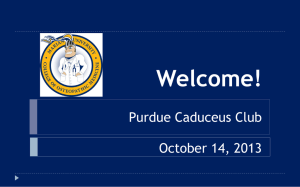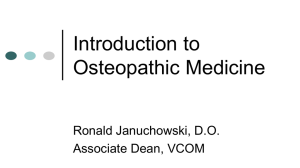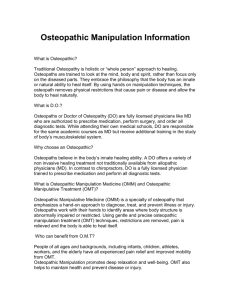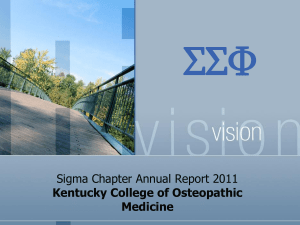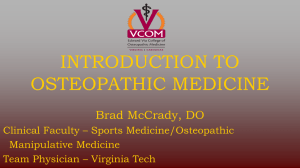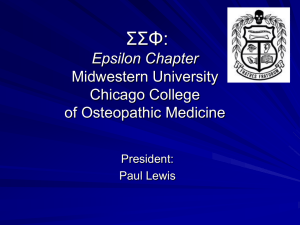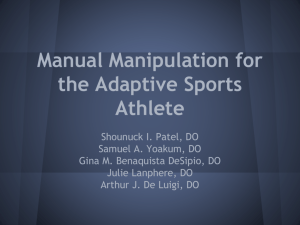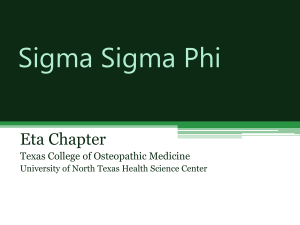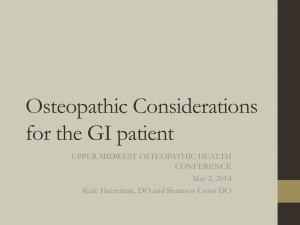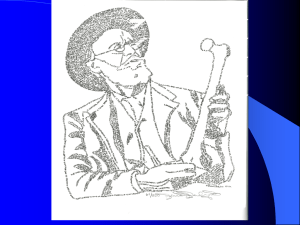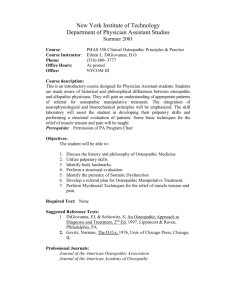Pelvic Pain: An Osteopathic Perspective
advertisement
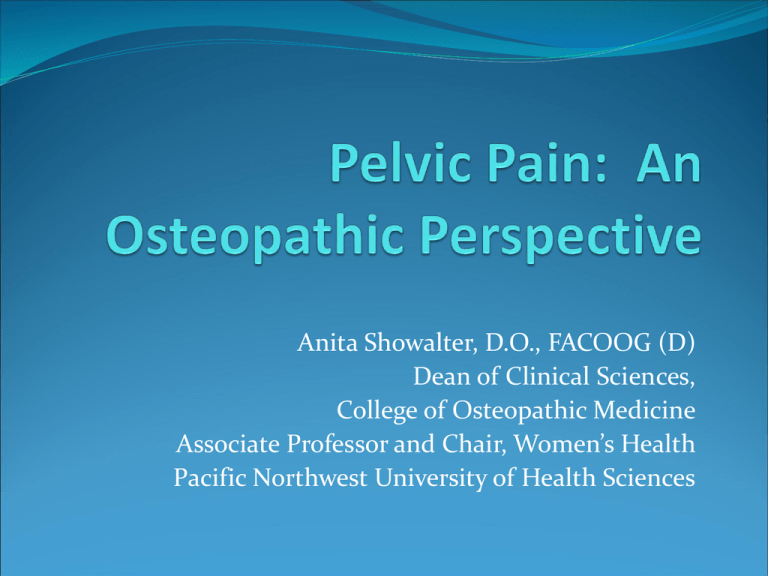
Anita Showalter, D.O., FACOOG (D) Dean of Clinical Sciences, College of Osteopathic Medicine Associate Professor and Chair, Women’s Health Pacific Northwest University of Health Sciences Objectives Discuss osteopathic philosophy in patient care Discuss the osteopathic approach to pelvic pain Review of pelvic anatomy Case presentations Osteopathic Philosophy The body is a unit; the person is a unit of body, mind and spirit. II. The body is capable of self regulation, self-healing and health maintenance. III. Structure and function are reciprocally interrelated. IV. Rational treatment is based upon an understanding of the basic principles of body unity, self-regulation, and the inter-relationship of structure and function. I. Foundations for Osteopathic Medicine The Founder of Osteopathic Medicine: A.T. Still “The Osteopath should find health. To find health should be the object of the doctor. Anyone can find disease.” A.T. Still, Philosophy of Osteopathy Somatic Dysfunction Definition: Impaired or altered function of related components of the somatic (body framework) system: Skeletal, arthrodial, and myofascial structures, and related vascular, lymphatic and neural elements. Somatic dysfunction is treatable using osteopathic manipulative treatment. Atlas of Osteopathic Techniques, 2nd edition, page 4 Osteopathic Treatment Application of manual techniques to somatic dysfunction Myofascial-articular Visceral-autonomic Somato-visceral Viscero-somatic Techniques Articular Myofascial Principles of Fascia At the time of early dissection, was thought to be an organ system Preservatives changed the properties of fascia and its importance was not realized Fascia has properties of strength and resilience Fascia can be influenced Fascia has a memory that connects to traumatic incidents Surgery can cause fascial strains if incisions are not carefully reapproximated Trauma can cause various fascial strain patterns The Fascial Being Patient History History of trauma MVA’s Falls Childbirth Rape Work Strain patterns Repetitive trauma Gynecologic Exam Is the cervix in the usual position Pain with insertion of the speculum? Initial Deep Bimanual Uterus midline? Adnexal tension/laxity? Osteopathic Examination Structural screening exam Look for areas of asymmetry Tissue texture changes Tension Bogginess Turgor Heat Red reflex Treating the Patient Rule out any emergent or urgent conditions requiring immediate medical or surgical intervention Do appropriate imaging studies Do a structural exam looking for somatic dysfunction or possible visero-somatic or somato-visceral conditions Explain rationale for OMT and treat patient on a trial basis Patient Follow Up Somatic dysfunction successfully treated may feel worse for several hours to a week – warn the patient! Successful treatment will then show improvement. Chronic conditions will recur over time. Each successful treatment will show increasing improvement and last for a longer period of time. Dosing of treatments is aimed at having the patient return at about the time symptoms recur and see progressively longer intervals between treatments. Problems of a Visceral Origin Viscero-somatic problems will respond initially but will quickly return within hours. If the treatment is not improving the patient’s symptoms, look for other causes. If imaging studies and laboratory are negative, consider scheduling a diagnostic laparoscopy. Patients with significant somatic dysfunction that did not get better with OMT will often improve for 3-4 months after diagnostic laparoscopy, then the symptoms tend to recur. Anatomy Review Anatomy Take Home Points Midline organs should be midline Paired organs should be symmetric Restrictions in the surrounding tissues and fascia may lead to tissue texture changes and pain There may be viscero-somatic and somato-visceral reflexes at play in pain syndromes Case #1 – History of Chief Complaint 42 year old with a 2 year history of intermitent vaginal burning and pain Frequent dyspareunia Treated numerous times for vaginal yeast without improvement Biopsy negative for pathologic changes Case #1 – Structural Exam ASIS low on right Outflare of right ilium, inflare of left Pubic shear low on right Sacral torsion Lumbar rotation Tissue texture changes in the thorax Vulva visually red. Tender areas in the vagina along the levators on the right. Case #1 - Treatment External somatic findings treated. Vaginal tender points treated with counterstrain (positioning for tissue changes) Redness dissipated while treating! PT for individualized exercises Continue treatments every 4 weeks Patient is symptom free most of the time Case #2 – History of Chief Complaint 44 year old female with a four year history of progressively severe pelvic pain Was treated with a TAH for endometriosis 4 years earlier When pain did not resolve, one ovary was removed. Later the other was as well. The pain persisted. No hormones were given because of the endometriosis. First patient visit, patient was sobbing in the fetal position unable to talk normally Case #2- Surgical Treatment The patient was so acute that despite negative ultrasound, I decided to do a diagnostic laparoscopy. She would barely let me touch her on the first visit, so OMT was held off. Massive adhesions of the small bowel to the anterior abdominal wall were left alone. Other adhesions were from the bowel to the vaginal cuff and bladder and were taken down. No active endometriosis was seen. Case #2 – Osteopathic Examination The patient’s pain was somewhat relieved by the surgery. She allowed manipulation after. The patient was noted to have a vertical AND an anterior/posterior shear (unusual finding). There was tenderness in the suprapubic fascia Sacral torsion noted Lumbar rotation noted Osteopathic Treatment Correction of the pubic shear brought the most pain relief, especially the AP component. Myofascial release of the suprapubic tissues and deep traction to prevent adhesion reformation were taught to the patient to do at home. Patient was seen weekly for treatment and managed with narcotics for pain. Patient was sent for prolotherapy on the pubic symphysis and sacroiliacs bilaterally. Had significant pain with the first treatment, and significant improvement with the second. Conclusions Pain management may often require a multiple disciplinary approach for successful treatment. Sometimes, symptoms of somatic dysfunction mimic other medical conditions prolonging successful diagnosis and treatment. Being aware of the possibility of somatic dysfunction in pain syndromes will lead to quicker diagnoses and prevent unnecessary intervention and diagnostic studies. ashowalter@pnwu.org References Interactive Pelvis and Perineum Primal Pictures, Inc. www.primalpictures.com An Osteopathic Approach to Diagnosis and Treatment, Eileen L Di Giovanna, Stanley Schiowitz, 1991. J.B.Lippincott Progressive inhibition of neuromuscular structures (PINS) technique, DJ Dowling ,J Am Osteopath Assoc, May 2000; 100: 285 - 298. An Osteopathic Approach to Treating Women With Chronic Pelvic Pain, Melicien A. Tettambel, J Am Osteopath Assoc, Sep 2005; 105: S20 - S22. Protocols for Osteopathic Manipulative Treatment (OMT).Revised July 1998. http://www.txosteo.org/Documents/OMT_protocols.pdf Maigne JY, Chatellier G, Faou ML, et al. The treatment of chronic coccydynia with intrarectal manipulation: a randomized controlled study. Spine. Aug 15 2006;31(18):E621-7. [Medline]. Foye PM. Finding the causes of coccydynia (coccygeal pain). J Bone Joint Surg Br [serial online]. January 18, 2007;Accessed April 16, 2007. Available at http://www.jbjs.org.uk/cgi/eletters/88-B/10/1388. Foye PM. Ganglion impar injection techniques for coccydynia (coccyx pain) and pelvic pain. Anesthesiology. May 2007;106(5):1062-3; author reply 1063. [Medline]. OMM Considerations in Patients with Chronic Pain. Michael Kuchera, DO. JAOA Supplement 4 Vol 105 No 9 Sept 2005 S29 References (cont) Osteopathic Considerations in Systemic Dysfunction, Second Edition, Michael & William Kuchera Efficacy of high-velocity low-amplitude manipulative technique in subjects with low back pain during menstrual cramping. David Boesler, DO. JAOA Vol 93 No2 February 1993 203 Manipulation for Dysmenorrhea. Mary Elizabeth Hitchcock, D.O. JAOA Vol. 75, June 1976 Tettambel, M. Gynecology. In Ward, RC, ed. FOUNDATIONS FOR OSTEOPATHIC MEDICINE, 2nd ed. Philadelphia, PA. Lippincott, Williams & Wilkins;2003;409-419. Tettambel, M. Obstetrics. In Ward, RC,ed. FOUNDATIONS FOR OSTEOPATHIC MEDICINE, 2nd ed. Philadelphia, PA. Lippincott, Williams & Wilkins; 2003; 450-461. Hodges SD, Eck JC, Humphreys SC. A treatment and outcomes analysis of patients with coccydynia. Spine J. Mar-Apr 2004;4(2):138-40. [Medline]. Maigne R. Diagnosis and treatment of pain of vertebral origin: a manual medicine approach. Baltimore: Williams & Wilkins, 1996:339–40. Mennell JB. The science and Art of Joint Manipulation. London: Churchill, 1952. http://www.sofmmoo.com/english_section/7_coccyx/coccyxmv.pdf
